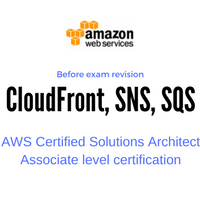Quick revision on topics AWS CloudFront, SNS, SQS before appearing AWS Certified Solutions Architect – Associate exam.

This article notes down a few important points about AWS (Amazon Web Services) CloudFront, SNS, and SQS. This can be helpful in last-minute revision before appearing for the AWS Certified Solutions Architect – Associate level certification exam.
This is third part of AWS CSA revision series. Rest of the series listed below :
- AWS CSA revision part I (EC2, S3, RDS)
- AWS CSA revision part II (VPC, Route53, IAM)
- AWS CSA revision part IV (SWF,Beanstalk, EMR, Cloudfomation)
In this article, we are checking out key points about CloudFront(CDN Content Delivery Network), SNS (Simple Notification Service), and SQS (Simple Queue Service).
Recommended read : AWS CSA exam preparation guide
Lets get started :
AWS Cloudfront
- Origin can be S3 bucket or CNAME of Elastic Load Balancer ELB
- S3 bucket as the origin. URL will be bucket_name.s3-reagion.cloudfront.net
- Private content sharing with signed URL with an expiration time limit
- To serve a new object version, create a new distribution, or create invalidation of the old objects. Since invalidation costs, creating new distribution always helps.
- Limits :
- 1,00,000 Requests per second per distribution
- 200 distributions per account
- 40Gbps speed per distribution
- 25 origins per distribution
- 20 GB max file size to serve
- By default, object expiration is 24 hours. The minimum TTL is 0.
Amazon SNS
- The latest addition to SNS is Lambda
- SNS has two clients: Publishers and subscribers
- Publishers communicate with subscribers by sending messages to the topic.
- Protocol supported :
- HTTP
- HTTPS
- SMS
- email-JSON
- Amazon SQS
- AWS Lambda
- SNS Topic of the same name can be created after 30-60 seconds the previous topic deleted.
Amazon SQS
- The default visibility timeout is 30 secs. The maximum is 12 hours.
- Mainly used to decouple your application
- The default period message stays in queue is 4 days. Min-Max periods are 1 min to 2 weeks.
- The maximum SQS message size is 256KB.
- Supports an unlimited number of queues and unlimited messages per queue.
- Long polling can be done from 1 to 20 secs.
Share Your Comments & Feedback: